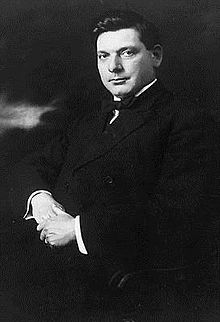Irving Gill
| Irving John Gill | |
|---|---|
 |
|
| Born |
April 26, 1870 Tully, New York |
| Died | October 7, 1936 (aged 66) Carlsbad, California |
| Nationality | American |
| Occupation | Architect |
| Spouse(s) | Marion Waugh Brashears |
| Buildings | |
Irving John Gill (April 26, 1870 – October 7, 1936), was an American architect. He did most of his work in Southern California, especially in San Diego. He is considered a pioneer of the modern movement in architecture. Twelve of his buildings throughout Southern California are listed on the National Register of Historic Places, and many others are designated as historic by local governments.
Gill was born on April 26, 1870, in Tully, New York to Joseph and Cynthia. His father was a farmer, and later a carpenter. As a child, Gill attended the Madison Street School in Syracuse.
By 1889, Gill was working as a draftsman under Ellis G. Hall in Syracuse. Then, in 1890, he moved to Chicago to work with Joseph Lyman Silsbee, who was Hall's partner years prior. Finally, in 1891, Gill went to Adler and Sullivan, where Frank Lloyd Wright hired him to work on his team. While there, he helped design the Transportation Building, an exhibit at the 1893 Chicago World's Fair. Gill would never see the end of that project, as he fell ill due to overwork. In 1893, the year of the Fair, he moved to San Diego to escape the memory of his failure.
Once in San Diego, Gill's health improved, and he began an architectural practice of his own. Though he was reported to have been working around this time, records of his projects were not well preserved.
In 1894, Gill partnered with Joseph Falkenham, who had built a successful practice of his own. The two formed a firm named "Falkenham & Gill, the Architects", and completed several projects, including some large commercial buildings.
Falkenham left San Diego in 1895, and Gill began to take on large residential projects for important figures in San Diego. He also worked on the Granger Hall for Ralph Granger, a local musician.
...
Wikipedia
